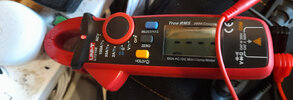You simply sign to confirm that, to the best of your knowledge, the work is compliant with BS7671
Unfortunately or maybe fortunately BS 7671 only gives the ground rules, so it may say volt drop shall not exceed 5% but it does not say how to achieve that.
In the main we consider a socket circuit will be loaded 20 amp at furthest point and 12 amp even distributed, so we consider the load on a 32 amp supply to be 26 amp when working out volt drop. This means for a 25 amp supply we consider it to be 25 amp. This means to cover the same area which would be covered by one ring final, we need 3 radials at 20 amp each, once we look at the cost of 2 extra RCBO's and the larger CU plus extra cable it is clearly more expensive to go down the radial route. We also have the inrush problem, and I know the problem trying to use a reduced voltage transformer when the premises has 20 amp type B MCB's. Some will work, but many will trip the MCB, but have no problem with a B32 MCB.
OK in domestic we do not tend to use 110 volt transformers, or welding sets, and one method is to used type C MCB's, but then the loop impedance becomes a problem.
For the DIY guy the loop impedance means ring finals need more expensive equipment, a plug in tester will show if under or over 1.9Ω but the ring final limit is 1.36Ω so the cheap plug in tester is no good.
However in real terms for DIY the biggest hurdle is to get the LABC to accept your signature. Even as an industrial electrician with all the test gear laid out for the inspector to see, with both of us holding the C&G 2391 certificates for inspecting and testing, we still had problems getting the LABC inspector to accept our signatures.
The only person who can sign the installation certificate is the person controlling the work, the LABC inspectors will not issue an installation certificate, as they have not been overseeing the whole of the work, they only visit a couple of times, so may issue a completion certificate, but not an installation certificate. In the main they want to shift the blame should anything go wrong, so will appoint some third party inspector who they trust, to inspect for them, at the owners cost.
The inspector can't sign the installation certificate, so uses the electrical installation condition report form, which is very similar to the installation certificate, but he is instructed to enter any deviations from the current BS 7671 it is not simply code 1, 2, or 3. He uses the form as if it was an installation certificate.
The inspectors have to be engaged before any work starts, and they will decide if the design is appropriate. The more info that is entered on the design, the less wriggle room there is latter for the inspectors to request extra work, for example if you show in your design the bathroom has an opening window and there will be no fan, the inspector has either to accept this, or say before you start he wants a fan, if however you don't stipulate either way, he can latter say I want a fan fitting, this happened to me, he said the opening window could be looked into by anyone calling at the house, so it would never be opened while some one was having a shower, so he wanted a fan. So a fan was fitted, it was never used, but had to be fitted. It would have been so much easier had we known before lights were wired up.
It seems the LABC does not like DIY, so they do all they can to discourage it, we would not have DIYed had we had an option, but the builder ran off in the middle of the job, and we had an amputee mother due home who needed a wet room. Far too much hassle working with LABC, when it came to full rewire, we used a scheme member firm so no hassle satisfying the whims of the LABC inspector.
But this forum is not who you need to ask, you need to ask the LABC inspector what he wants, it is his call, not ours.
The on site guide lists how many sockets should be fitted in each room, however not seen many homes where there are that many sockets. The portal has a load of official guides saying where sockets should be fitted, can't remember off hand, but know not to be fitted in corners as wheel chair users can't reach them. Also heights, it seems they will allow heights to match with a part re-wire, but again down to the LABC inspector, so if you want sockets not at the prescribed heights, put it in your plan, so it is agreed before you start.
There have be huge arguments about the heights of thermostats, in my house most are at 9 inches above floor hight, no real option as built into the radiators supply pipes, but the parts in the portal give a maximum and minimum height for items to be viewed, and items to be operated by hand, near impossible to comply with both, and of course needs to be where it can record room temperature, never tattled a building inspector on where a free standing thermostat can be mounted, which is why it is so daft.
I think you are very brave or naive trying to DIY home rewire using the LABC route, love to hear how you get on. My son and I would not want to do it all again.



